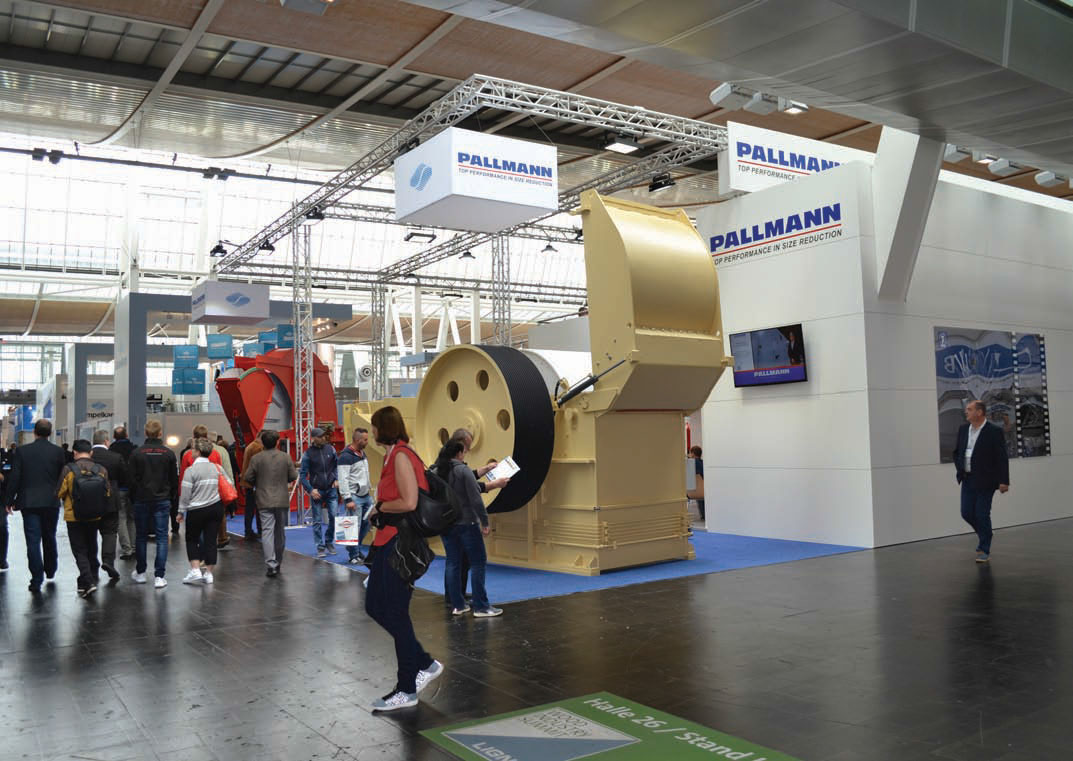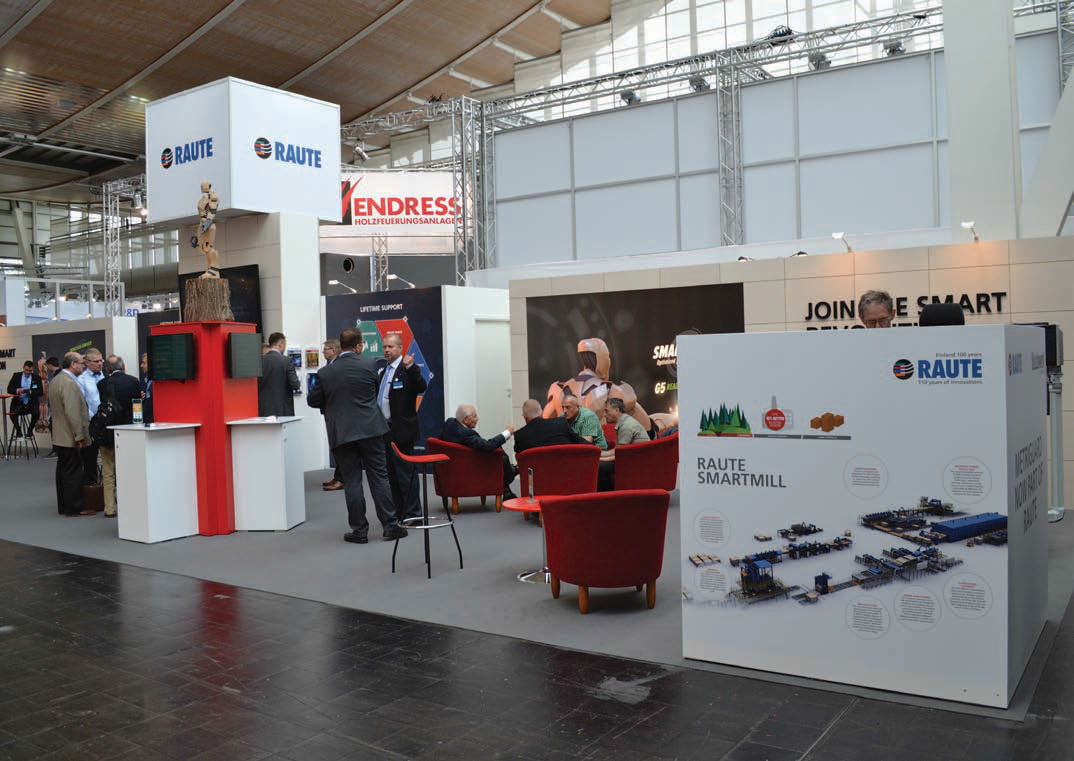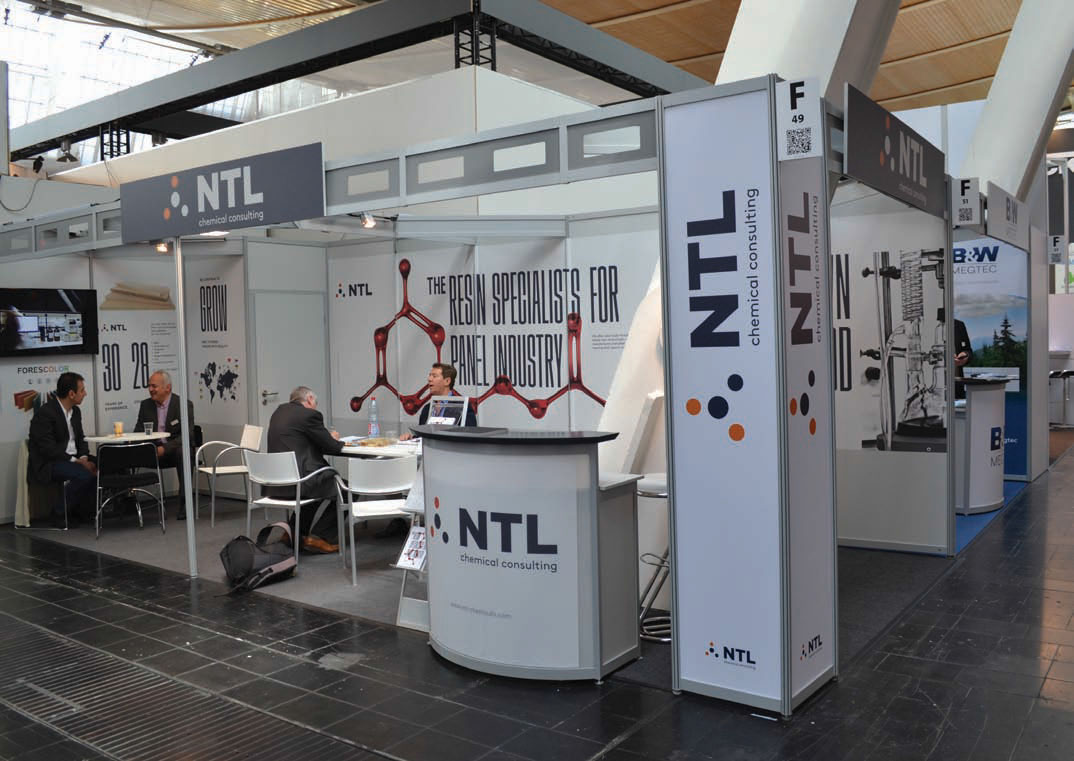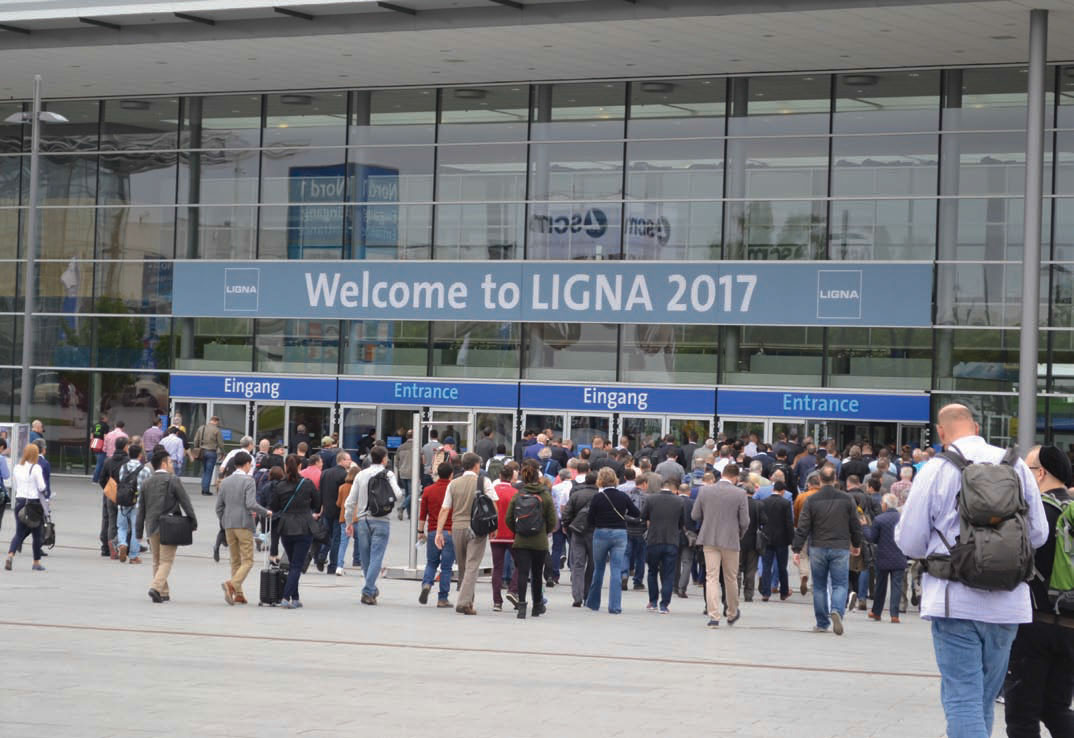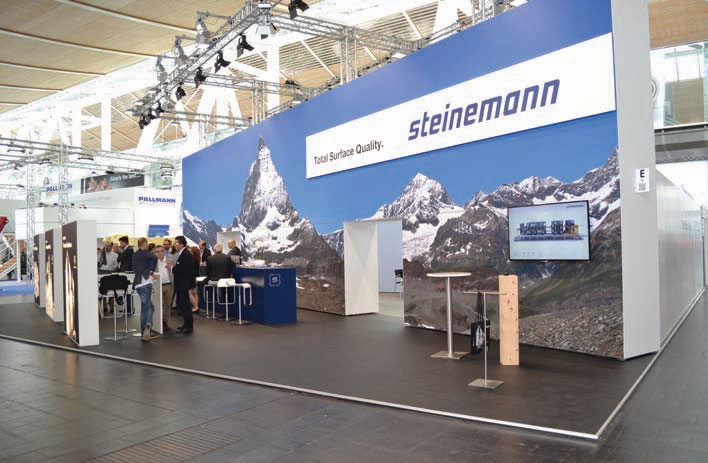Lively Ligna best for years
12 July 2017The Biennial Ligna 2017 took place in Hannover in May. The biggest trade fair-ground in the world hosted the most important gathering of panel machinery makers and users and demonstrated that the industry is recovering from its doldrums and is on the way up. Julian Champkin was there
We have been at every edition of Ligna since 1987,” said Staffan Karlsson, global manager of the steel belt division of Sandvik. “There is a reason: All the important players are here.” Ligna 2017 was no exception. The show was big; it was successful; and indeed all the key players were there.
The venue was Hannover, Germany; the focus as announced by the organisers, Deutsche Messe, was intelligent concepts for integrated manufacturing across multiple links in the wood processing chain – which basically means that no one element of manufacture can be considered in isolation. The arrangement of exhibitors by hall was new. All panel connected stands were, for the first time, placed together in the giant Hall 26, with automation in Hall 16 and surface treatment companies in Hall 17.
Most exhibitors seemed very happy with that; for some, though, such as Holtec, whose key expertise covers several areas, the arrangement involved having stands in two different stalls with staff running between them. Attendances, it was agreed, were well up on 2015, with 93,000 visitors from more than 100 different countries. And here is what was on show.
The huge stands of Dieffenbacher, and of Siempelkamp, dominated the hall. One can only admire the effort that must have gone into them – and the impressive and successful results. Siempelkamp was introducing Generation 9 of its celebrated ContiRoll press. More than 60 of its Generation 8 presses have been installed worldwide since they were introduced six years ago. The hope is that Generation 9 will have a similar lifespan. “After 50 Generation 9 lines are sold we will talk about Generation 10,” said the company.
Since 1st April, Siempelkamp has wholly owned the size-reduction specialist Pallmann, some of whose huge machinery was on display in the adjacent booth.
Dieffenbacher reported good activity in the market overall, and forecast at least a short-term continuation of that situation. "We expect no big decrease in the next half-year. After that it is very hard to predict" said Wolf-Gerd Dieffenbacher, President and CEO. “South-east Asia is still very active; we have discussions on projects in South America; North America is finally coming up with new projects again – an OSB line for Arauco in Michigan, for example. Europe, as always, is poor for greenfield sites but not for renewal projects such as replacing elements not at the forefront of what is technologically possible, for example installing robotic stacking lines. In Russia there are projects coming up – we have just opened up a service centre in Russia to support our customers there. And it is a look into the future. There will be other projects in Russia for sure in the next few years.”
That optimistic outlook was shared by every exhibitor to whom we spoke. The panel market is beginning to boom and the Ligna show was reflecting it. “Better than the last edition,” said Bethania Blum of Brazilian resin producers Isogama, which was presenting its new UF resin catalyst Isocat HP.
Ulf Eriksson of Valmet, showing the company’s PeriVapor steam-economising system and the wear-resistant EvoThrottle blow valve, said the same – he had sold one of the latter to a Chinese buyer at the show that morning.
“Surprisingly good attendances: I didn’t expect it,” said Hajo Binder of equipment suppliers Modul Systeme; and those responses were typical.
Several common themes could be discerned.
One of course was automation and the ever-spreading Industry 4.0; techniques for economy and efficiency gains went hand in hand. Another theme was customisation – supplying machinery tailor-made to individual requirements.
Sanding specialist IMEAS can stand as an example of all those threads. It was showing the latest version of its Evol range of sanding machines – “the product,” said sales manager Francesco Zenere, "of 35 years' thinking about what sort of machine we should be aiming to make.” The analogy he gave is of a family saloon or a sports car: the goal defines the machine which results. “No one type or size fits all, so we tailor each one to the customer’s needs. They will enjoy the flexibility we can offer. Faster sanding speeds – 150m a minute with an option to go to 200m a minute – are available; but we have also concentrated on ease of maintenance and ease of accessibility.” Quick-opening locking pins make changing belts faster and easier and greatly reduce downtime for such routine operations. And – a nice final touch– “we have changed the doors to a more pleasing design – aesthetics are worth the effort.”
And of course the machine is fully Industry 4.0 compatible to give feedback to the line. Every high-speed bearing has a vibration monitor to indicate not just if the bearing needs replacing now but if it is in a state to need replacing soon. Self adjusting sanding pressures and profiles for wear and tear give greater consistency in the thickness of the final board.
Steinemann, also sanding specialists, from Switzerland on a stand wonderfully dominated by a vast photograph of the Matterhorn, had a headset of 3-D virtual reality goggles that let you venture inside its next generation of sander, the Satos TSQ, and explore its inner workings in action. That too has a new locking system for the belt-change operation that allows gentler and more convenient belt changes. Measuring of sanding pressure is automatic but direct now, measured in newtons, rather than being calculated from the motor load amperage. The system can also analyse chatter marks and tell from their wavelength whether a worn bearing or belt or roller is causing them – and which particular bearing, belt or roller it is. The company's BQC or Board Quality Cockpit is “more than industry 4.0," said Markus Müller, VP Sales and Marketing.
“It is complete data management. We call it Ludi Benz, after our technician who has been with us for 30 years: we downloaded his brain into it – or at least his expertise and analysis skills. It is an intelligent system on top of what is here today.” Ligna of course hosts all the mainstream companies. It is also an excellent showcase for those who occupy specialist or niche markets and have the expertise to survive in them.
Berndorf Band are the only makers of embossed continuous steel belts for in-register printing. The company was showing a new mobile belt sander used by its service technicians for on-site scratch and burr removal – quicker and easier to set up and greatly reducing down-times.
Holtec, the woodyard people, said it had equipped 90% of the woodyards in all new OSB installations in the EU and Russia since 2000. Its spraying system to condition iced-up logs avoids the traditional log ponds. “We have supplied Egger, Kronospan in Belarus, and MLT’s OSB production line in Russia,” said Alexander Gebele.
Binos, too, occupies a niche and offers tailor-made solutions. Its Ultra Scraper was being presented as a new upgrade at Ligna. It goes inside the dosing bin, making the mat more even before it enters the press, thus saving material and energy costs. “Since we are not mainstream we market customer solutions,” said managing director Achim Hackspiel.
“We are tailor-making more specialised, alternative products than the big guns can offer. People coming here look for some uniqueness which they can find with us. Those are our future customers, and there are plenty of them around. We can say to a customer “Here is our toolbox; what would you like us to make for you with it?”
Weko was showing its mat moistening systems. “Spraying softens the mat surface. It reduces press times by up to 15% and a gives a higher density of board for the same pressure. Especially, it gives a peak density near the surface, which is of course is where the bending strength of a panel resides,” said Robert Mascherpa. Uniform and even application of the fluids is essential. A spinning disc system atomises the fluid, while staggered spraying fan outlets give an even, overlapping spray pattern and a droplet size that has just the right amount of kinetic energy to ensure that all the solution is delivered to the mat with no spray drift or evaporation.
Short-cycle presses are another niche market, one in which Wemhöner is sole occupant and flourishing. The company speciality is surface finishing in three dimensions. “We are one of the few companies in the world who can do 3-D pressing on both sides of a panel” said managing partner Heiner Wemhöner.
The company had even brought a complete membrane press to LIGNA to demonstrate the technique. It has made big investments in its manufacturing plant at Herford, in Germany; but not to increase capacity. "The investment is for optimising our operation. Surface technology – lacquering and so on – is our world. We feel especially for the surface of the panels.” He points with some pride to the floor of the booth which is to all appearances wood, but in fact has a printed paper surface pressed onto a substrate. “It is easy to clean; it's hygienic; it’s hard-wearing. Medical practices and hospitals use it.”
Digitalisation and automation in the progress towards Industry 4.0 was, of course, near-universally stressed. An aspect of it shown by several was the app, downloadable to smart-phone or tablet, giving operators full knowledge of what their machines were up to no matter where the operators, or the machines, are. Dieffenbacher introduced its “My Dieffenbacher” service app, intended to be on every operator’s phone or i-pad.
“Information that used to be in 50 paper binders that were not up to date, plus data-bases, manuals, documentation, spare part inventories – all of that is in the app, and it can link to the database at Dieffenbacher as well. It can also update components, tell you for example of motors that can replace an older model.
This is the real way to go,” said Wolf- Gerd Dieffenbacher. “It is the next level of efficiency. It is how you handle your private life these days, so it should be how you handle your business life as well. The younger generation takes such things for granted.”
Raute, demonstrating its Smartmill for plywood production under the motto “Join the smart revolution”, showed tablet software to automate planning of debarking and chipping operations.
"We can run a virtual smart mill on our tablet” said Markus Sirviö, “so we can try out different procedures in advance, and optimise the whole process in virtual reality in a couple of minutes, compared with eight hours of experimenting in a physical mill – and without using the energy or materials that those reallife tryouts would need. It is a huge development in digitalisation.” Savings of up to 15% in raw material use are claimed. Grecon was demonstrating its app for mobile emergency management.
Managing Director Uwe Kahman described it: “In a fire situation people are confused and nervous and may forget the most important things they are supposed to do. The app defines the people who need to be informed of the fire; each gets sent a list of things to do. The app monitors who reacted and when, what they did, and so on; and all is recorded for post-fire analysis.”
Grecon also had a new logo and new products, among them Flamewolf, an extremely precise flame detection and extinguishing system. It had sold the first one at its Ligna booth the day we visited.
Italian press-maker Pagnoni was showing its SCL press lines, able to produce not only one-sided embossedin- register flooring but also to combine simultaneous registered lamination of both top and bottom décor papers for a definitive synchronous effect for furniture.
Wet-end and recycling specialist Instalmec was feeling confident. Turnover has increased, by 30 to 40% in the last two to three years. Founder Adreano Stocco enthused over the increasing use of recycled wood and the 75tph dryer and cleaning system the company had installed at Kronospan’s particleboard plant at Burgos. “It produces panels from 100% recycled wood with a quality higher than from virgin. That was an important test for us,” he said. “The Kronospan group has noticed that our plants are performing well. And it has chosen us for its next large project. And with virgin wood prices being forced up by biomass demand, it makes sense to use recycled raw material.” Prices currently are around €20 per tonne for recycled wood, €60/80 per tonne for virgin. “And of course the humidity content is lower. As is the silica content, when put through Instalmec’s recycling tower screens.”
Among innovations for economy and efficiency, Imal-Pal, part of Panel Alliance, was showing the Dynasteam, which injects dry steam into the mat before pressing – which the company says can increase production rates by 30% – and a high pressure resination system which reduces resin use by up to 20%.
Kleiberit’s hot-coating line gives highgloss finishes that, importantly for the end-user, do not chip when cutting or being drilled, giving the savings at that last stage where a wasted board has already been the subject of much effort and input.
Vits, now with Wessel, IDA and Deurowood making up the Deurotech group, was demonstrating its fully integrated control system for registered embossing. Two cameras and a laser doppler system accurately measure the paper web and position the cutting line; costs are reduced through reduction of wastage and raw material use.
Luxembourg-based toolmakers Ceratzit presented coated knives for wood machining, with long-lasting cutting edges, and similar innovations for saw tips, again reducing down-times.
NTL had a new wood-hardening method of impregnating softwood plywood veneers with resin under pressure to give a durability similar to that of hardwood. “I have never seen a Ligna so busy,” said Achim Hackspiel of Binos. “We are getting good feedback, and all the enquiries are positive and serious about ordering. No-one had been enquiring just to pass the time. That is a big change from some previous years.”
The panel industry is healthy, developing new methods and techniques and is on the move at last. We can look forward to LIGNA 2019 with optimism – and with curiosity as to what will be on show and available by then.